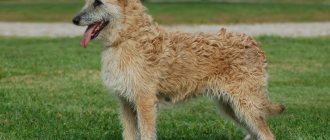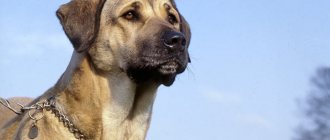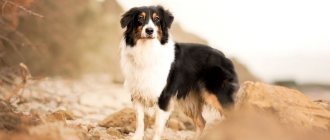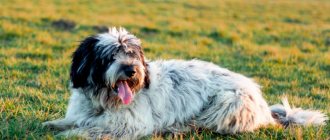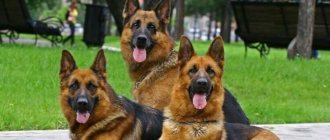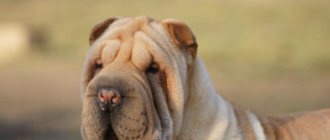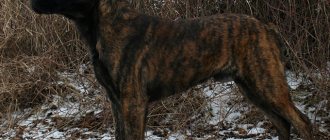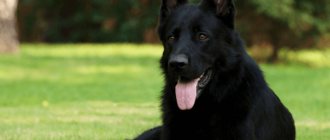The noble appearance of the Major Shepherd makes an impression at first sight. Graceful, fast, brave and loyal “Spaniards” are today popular all over the world, including in Russia. Unfortunately, this is a small and rare breed, but the greater the interest in it. This is a versatile dog with a long and complicated history.
They can be excellent guards and affectionate companions. Once upon a time, their purpose was not limited to herding livestock; they actively took part in fighting rings.
Care and maintenance
It is not recommended to keep this dog in an apartment.
She needs a spacious house in which she can run or play. It is better to keep it at the dacha in the house itself or even in a booth on the property. The breed is quite unpretentious and will cope with almost all weather conditions (except for very extreme ones). Therefore, in a little frost, you can leave her in the kennel. If you decide to get this dog, then you should immediately decide on the purpose of breeding this breed. The Mallorcan Shepherd should not be purchased as a cute pet, but as a working dog or a dog for exhibitions and sports. In principle, it can even be used for hunting, although you will have to use specific methods of training and maintenance.
When buying a puppy, you should pay attention to the certificates of both parents. A dog with a good pedigree will inherit all the positive skills of its ancestors
Don't forget to vaccinate your dog against various diseases.
The dog has a very large hidden resource of strength and agility. They definitely need to be developed. From very early childhood, the puppy must be kept in complete strictness, maintaining ideal discipline. A poorly trained dog can be dangerous to society. Start training from the moment the puppy arrives in the house. Reinforce any correctly executed command with a tasty reward.
If you encounter any problems during your upbringing, you will need to contact specialists. If a specialist offers you to send your dog to a boarding house, do not agree. Training should be carried out by the owner, albeit under the watchful supervision of an instructor. It is necessary to maintain not only the physical condition of the dog in good condition, but also its aesthetic appearance.
How to maintain and care
This dog desperately needs space. For this reason, you need to take her for long walks often. The Mallorcan Shepherd needs to have a good run outside and throw out some of its energetic energy. A country house would be an ideal option for keeping dogs of this breed. The Mallorcan Shepherd tolerates both frost and heat well. They can be kept outside, in a kennel, not forgetting, of course, long walks. Short-haired dogs do not require special care. From time to time they need to be combed out with a brush. In addition, it is necessary to treat your dog against ticks and worms in a timely manner. It is obligatory to go to the doctor once a year.
Care and maintenance
Greek Shepherd: description of the breed, character, photo
They are practically easy to care for, but in the absence of the necessary training, they can be eccentric and overly active. You should start classes from 3 to 4 months of age, otherwise you may miss the moment.
An important component is coat care and proper nutrition, monitoring of general condition, and disease prevention.
Bathing the dog - as it gets dirty, it is recommended after each walk to wipe the body with a damp cloth, as well as the area of the paw pads, between the toes. Use only products for animals, human shampoos, which can cause allergies. The water should not be too hot. Combing the coat once every 2-3 weeks, during the molting period - every day. Use a medium-length brush, and during the molting period, use a hard, special slicker brush. Cleaning the ears 2-3 times a month, using a cotton swab or sticks soaked in a special lotion
Inspect your ears for parasites; they often hide on the outer and inner sides of the ear. It is important to treat your dog against parasites - fleas, ticks, and regular deworming. For puppies more often than adults
Remember to be vaccinated and the vaccination regime. It is recommended to wipe your eyes regularly with a cotton pad soaked in a chamomile solution to remove discharge. Brushing your teeth - once a month, using a pet brush, or using bones - treats that can remove plaque from your teeth. If there is an unpleasant odor, it is recommended to consult a veterinarian; the odor may be a consequence of poor digestion or dental problems. Trim the claws 1-2 times a month using a specialized nail clipper. Regularly inspect the mucous membranes, skin, and fur.
Life expectancy, as well as its quality, directly depends on the dog’s nutrition and regular physical activity.
Mallorcan Shepherd
The best service dog from the USSR, the Central European Shepherd (veo): description and character of the breed
For most dog lovers, the animal is not only a pet protecting the home, but also a faithful friend. The most loyal types of breeds include the Major Shepherd.
Story
Balrocks. Historians say that the mention of Neve brought dogs, which later began to live with the dogs of the local population of the islands.
Character
The shepherd's character is tireless. He is distinguished by fortitude as well as physical strength. The newly born puppies already have these qualities.
Paro z. The Shepherd has excellent speed, courage and endurance.
The Shepherd needs a lot of space. She needs walks, good, long runs outside. For her, the release of accumulated energy is important. The dog tolerates climatic conditions such as heat and frost well. Possible swarm of booths). They are easy to care for. The owners carry out timely prevention against worms and treat them against ticks. Brushing from time to time. A veterinary examination is required annually.
• Animal weight - 35-45 kilograms; • Height reaches -70 centimeters; • The dog is endowed with a powerful neck and well-developed muscles; • Ears are medium-sized, triangular, drooping; • Eyes are small, color – brown, shape – oval; • The shepherd's back is powerful; • Round breasts, medium size; • Nature has endowed the Major Shepherd with a strong jaw and good canines.
Compatibility with other animals
It becomes a frequent occurrence that the shepherd takes a leading position and suppresses the surrounding brothers. The owner must take into account this feature of the breed and be prepared to react if the ward shows a desire to fight.
Flaws
very experienced dog breeders. Only seasoned dog lovers can give you a lot of love and attention.
Beginners are not recommended to have such a serious dog. It is necessary either for sports competitions or official activities. The courage and dexterity of dogs involves performing complex tasks. From the first days it is necessary to determine who is in charge in the house and maintain discipline. If necessary, seek help from a specialist.
Training
The owner should train the animal when it reaches 3-4 months. When they start training, they actively begin training. Training can be entrusted to a specialist at this stage. Or, after consulting with a dog handler, conduct independent training.
Diseases and treatment
If the animal is not properly maintained, problems with the musculoskeletal system may occur. This is hip dysplasia, dynamic movement, and restriction in long-term exercise of the dog’s diet.
Training
For better education, an age from 3 to 4 months is suitable; it is recommended to start training with the easiest commands, gradually increasing the intensity and duration.
The owner of the pet must be involved in the upbringing, otherwise nothing will come of it.
At the initial stage, you need to spend 10 -20 minutes a day, after 6 - 7 months, begin active learning. You can go through special programs with a specialist, and then continue studying on your own.
Description[edit | edit code]
Central Asian Shepherd Dog (Alabai): description, character, features of care and education of puppies (140 photos)
Excerpts from the breed standard:
- Basic proportions
: The length of the body is equal to the height of the withers. The length of the muzzle is equal to the length of the cranial part of the head. The length of the skull is equal to the length of the neck. - The character
is calm and self-possessed. As a rule, this dog has one owner and it is very difficult to get used to another person. The dog is very smart, obedient, affectionate, far from timid, but well controlled. - The head
has a triangular profile, quite wide in the forehead area. The bridge of the nose is parallel to the line of the skull. The width of the muzzle is equal to the width of the skull. A massive head is a disadvantage. - The muzzle
is strong, wide and wedge-shaped. The bridge of the nose is straight. - The nose
is dull. The nose is square in shape. The nostrils are large and open. - Lips
are black and dry. - The teeth
are large, strong and white. Scissor bite. Molars are developed. - The eyes
are almond-shaped, medium-sized. Rosemary honey color. - The eyelids are
black, tightly fitting to the eyeballs. - The ears
are set high, small, triangular in shape. The ears are not cropped. - The neck
is strong and muscular. Proportional to the body and head. Round in cross section. The skin is dense and elastic. - The chest
is wide and deep to the level of the elbows. Forbrust is moderately developed. - The croup
is slightly sloping, wide, strong and well muscled. - The tail
is set low, thick at the base, long and straight. The tail is not docked. - The forelimbs
are strong and large-boned. The length of the forearm and wrist is approximately equal to the length of the back. The elbows are pressed to the body, not turned out or tucked under the body. The forearms are strong and perpendicular to the support. The pasterns are short and slightly sloping. The paws are similar to those of a hare, but shorter and wider. The toes are flexible and strong. The claws are dark. Dewclaws should be removed. - The hind legs
are muscular and strong. The hock joint is open. The thighs are well muscled and sculpted. The lower legs are long and muscular. The hock joints are well formed. The paws, like the front ones, are similar to those of a hare, but somewhat wider. - The skin
is elastic, without folds. - The coat
is short and close-lying. The length of the guard hair is from 1.5 to 3 cm. In the lumbar region, the hair is slightly longer (up to 7 cm) and can be slightly wavy. Overgrowth depends on the time of year and natural conditions of the area. In winter, fur grows not only on the body and limbs, but also on the ears. - Color
: Only black color is allowed. There may be a small white spot on the chest. In addition, white spots are acceptable on the neck, lower limbs and paws. However, the pure black color is most valued. - Height and body weight
: Height at the withers of males from 66 to 73 cm, females 62-68 cm. Weight: 35-40 kg.
| Dog breeds |
| Australian Short-tailed Cattle Dog • Australian Shepherd • Australian Heeler • Australian Cattle Dog • Australian Kettle • Australian Terrier • Azawakh • Aidi • Alabai • Alano • Alpine Dachshund • American Water Spaniel • English Bulldog • English Coonhound • English Springer Spaniel • Appenzeller Mountain Dog • Affenpinscher • Greater Swiss Mountain Dog • White Swiss Shepherd • Barbet • Bergamasco Shepherd • Bichon Frize • Beauceron • Catahoula Bulldog • Buryat Mongolian Wolfhound • Welsh Corgi • West Highland White Terrier • East European Shepherd • Havanese Bichon • Gampr • Dutch Smoushond • Blue Gascony Basset • Dalmatian • Dandie Dinmont Terrier • Doberman Pinscher • Longhaired Collie • Drathaar • Eurasier • Wire Fox Terrier • Golden Retriever • Irish Water Spaniel • Yorkshire Terrier • Cane Corso • Kerry Blue Terrier • Cairn Terrier • Cromforlander • King Charles Spaniel • Shorthaired Collie • Komondor • Kuvasz • Kurzhaar • Labrador Retriever • Langhaar • Lhasa Apso • Mallorcan Shepherd • Maltese • Miniature Schnauzer • Pug • Moscow Watchdog • German Boxer • Auvergne Pointer • Otterhound • Puggle • Pekingese • Pyrenean Shepherd • Poodle • Puli • Pumi • Samoyed • Saint-Germain Braque • Slovakian Dude • Dachshund • Husky • Hovawart • Croatian Shepherd • Miniature Schnauzer • Chinook • Chihuahua • Swedish Lapphund • Shih Tzu • Sheltie • Sholoitzcuintle • Entlebucher Mountain Dog • Estrela Shepherd • Jagdterrier • Japanese Chin |
| Herding dog breeds |
| Breeds for grazing and driving livestock |
Description
The Mallorcan Shepherd (or Major Shepherd, Perro de Pastor Mallorquin, Ca de Bestiar) is an ancient Spanish breed of dog with universal inclinations.
In her homeland, she helped shepherds herd herds of livestock and guard their owners' homes, and participated in bloody dog fights.
Nowadays, he serves in law enforcement agencies, performs the duties of a bodyguard and watchman, and is also a pet.
Peculiarities
Today there are two varieties:
Ca de Bestiara has a long-haired and a short-haired breed, both of which are charcoal-black in color.
The short-haired shepherd is more popular because it is easy to care for.
The true origin of the breed is unknown and remains an absolute mystery. It is believed that dogs appeared in Spain in the 13th century or much later, and their spread began from the Balearic Islands.
Distinctive features
The head is triangular, massive with a wide forehead. The length of the skull, muzzle and neck is the same. The muzzle is strong, elongated, wedge-shaped, the width corresponds to the width of the skull. The transition of the forehead to the muzzle is not clearly expressed.
The teeth are white, large and strong. Scissor bite.
The ears are thick, small compact in size, triangular, hanging with a high set.
The eyes are medium-sized, slanted. The color of the iris is closer to honey.
The body is strong, muscular with strong bones. The length of the body and the height of the dog at the withers are equal. The neck is powerful, athletic, in proportion to the body and head. The back is straight and powerful. The croup is slightly sloping, strong, spacious and muscular. The chest is distinctly wide and deep, reaching the line of the elbow joints.
The legs are strong, powerful, bony. The paws are hare-shaped, but much wider and shorter. Fingers of good flexibility, strong with dark claws.
The hair is short, close-lying, straight or long and wavy. The texture of both wool options is soft, fine and waterproof. The undercoat is well developed. The color is black or black with white markings on the chest, neck or paws.
Perro de Pastor Mallorquin is able to remember more than 100 commands.
Character
The Mallorcan Shepherd is smart, active, and very affectionate. With the right educational approach, it is a fairly obedient dog with a calm and self-possessed, but strong-willed temperament.
Excellent controllability, masters commands and other training tricks well. However, he has a tendency towards leadership, independent decision-making and independence, so difficulties may arise during upbringing.
He adores and sincerely loves his owner, considers him the only one, so it is very difficult to get used to the new owner, it is unlikely that he will become his true friend.
He treats children with love , but you should not leave a child alone with a pet, since the dog’s outward calm can instantly turn into aggression.
Relationships with pets are difficult , especially with other dogs, with whom he can behave impudently and arrogantly.
It perceives strangers with hostility , since by its nature it is a guard breed. She has established herself as a brave guard and bodyguard of the owner and his possessions.
Service German Shepherds are capable of obeying all employees, but the Mallorcan Shepherd exclusively obeys only one employee.
Features of maintenance and care
The Mallorcan Shepherd, who loves to play and run, is suitable for living in a country house or in a private house. The animal easily tolerates any weather and climatic conditions, is not afraid of heat and cold, so you can keep it outside by installing a comfortable booth.
An indispensable condition is long walks with jogging and physical activity. This will help avoid unnecessary excess energy that the animal can direct to damage property.
Shepherd care includes:
- periodic combing (once every 2 weeks), a short-haired pet can be combed with a brush; for long hair, it is better to use a furminator; during molting, a special slicker is used to remove old hair and undercoat;
- after a walk, the animal’s body and its paws are wiped with a damp cloth, and after severe contamination, they are bathed with warm water and pet shampoo;
- You should clean your dog’s ears twice a month;
- wipe the eyes daily with chamomile infusion, removing discharge and dry crusts;
- once or twice every 30 days you need to cut your claws using specialized clippers;
- To keep a shepherd’s teeth clean, the pet is given appropriate treats or manually brushed with a toothpaste to remove tartar and plaque.
We must not forget about regular vaccination of the animal against ticks, as well as a number of diseases to which it is susceptible; before this, deworming is mandatory.
With regular long-term physical exercise and a balanced diet, a dog can live as long as possible - up to 15 years.
Nutrition
The easiest way is to choose ready-made extra-class or holistic food, which provides the necessary microelements and a balanced menu. If you decide to feed natural food, follow some rules. There is no need to give fatty, floury, spicy, salty and sweet foods. The dog should not experience problems with the stomach, teeth and heart.
The best options are boiled lean meat and boneless fish, as well as cereal porridge in broth with the addition of vegetable oil. Include more dairy products, it is good for bones. Give vitamins and fiber in the form of vegetables. Potatoes and pasta are allowed no more than once a week. Sometimes you can have a raw egg or fruit.
Don't forget to pamper your pet with a large bone. Regarding nutrition, consult your veterinarian, he will help you create a balanced diet.
An important rule that should never be broken - the water bowl must always be clean and filled
How to choose the best puppy
When buying a dog, there are points that you should pay special attention to. They will help you avoid fatal mistakes and further problems with education and training.
- Nursery, breeders. Must have a reliable reputation and many years of experience working with dogs. The worst sign is if different breeds are sold in one place. This cannot be allowed, these are clearly scammers and resellers. You should interview your friends, chat on forums, and carefully study the topic of selling puppies. Only after this make a deal.
- Documentation. Each puppy must have a veterinary passport with notes on initial vaccinations and date of birth. Additionally, a pedigree is drawn up indicating parents, grandparents, and branches of genetic lines. Usually purchased at an additional cost. The winners of exhibitions and showrooms always have awards that they are proud of. Ask the seller to show them so that the evidence of the purity of the breed is not unfounded.
- Visual inspection. Regardless of the breed, the dog must stand firmly on its limbs. Their paws are strong, strong, with large “growth bumps” just above the front carpus. In smooth-haired dogs, the axial hairs lie tightly, do not bristle, and shine in the light. In medium- and long-haired dogs, puppy “fluff” remains for a long time, which will eventually develop into an undercoat. The dog should not have an unpleasant odor. If there is no discharge from the eyes or genital openings, then everything is in order.
- Behavior. A good puppy is always playful, cheerful, mischievous and reckless. He will happily run up to a stranger, begin to lick and bite. A cowardly dog shows signs of fear: loud barking, howling, raising of fur at the withers, near the pelvic joints. Regardless of the breed, in puppyhood all are initially friendly to humans. As it grows, it should react sensitively to strangers by barking.
By following simple rules, you are guaranteed to get a puppy that will grow into a beautiful, stately, caring dog - a reliable companion.
Breeds from the same group
- Australian Shepherd
- Alpine Mastiff (St. Bernard, St. Bernard's dog, Bernardiner)
- American Akita (Akita Matagi or Large Japanese Dog)
- American Bulldog
- American Pit Bull Terrier
- American Staffordshire Terrier
- English bulldog
- Bavarian Mountain Hound (Bavarian Track Hound, Bavarian Hound p.
- Basque Shepherd Dog (euskal artzain txakurra)
- Belgian Shepherd
- Belgian Malinois (Belgian Shepherd)
- Belgian Tervuren
- Bernese Mountain Cattle Dog (Bernese Mountain Dog)
- Bloodhound (Chien De Saint Hubert)
- Bobtail (Old English Sheepdog)
- Large Japanese Dog (BJA, American Akita)
- Briard (French Shepherd Shepherd, French Longhaired Shepherd
- Bullmastiff
- Bull Terrier
- Weller
- East European Shepherd
- Smooth coated Saint Bernard
- Smooth Fox Terrier
- Doberman (Doberman pinscher)
- Jämtland Laika (Emthund, Yemthund, Yamthund, or Swedish Elkhound,
- Irish Terrier
- Ca de Bestiar (Perrot De Pastor Mallorquin, Mallorcan Sheepdog)
- Ca De Bo (Perro Dogo Mallorquin, Dogo Mallorca, Perro de Presa Major
- Dogo Canario (Dogo Canario, Mastiff Canario, Canarian dog)
- Cane Corso Italiano
- Karst Shepherd Dog (Kraski Ovchar)
- Collie (Scottish Sheepdog)
- Landseer (Landseer)
- Lancashire Heeler
- Leonberger
- Mastino Neapolitano (Neapolitan Mastiff)
- Miniature Schnauzer
- Moody
- German boxer
- German Spitz large
- Newfoundland
- Pyrenean Mastiff
- Pitbull
- Polish Lowland Sheepdog
- Portuguese Watch (Rafeiro do Alentejo, Rafeiro do Alentejo, Ra
- Poodle
- Puli (Hungarian Water Dog, Mop Dog)
- Rafeiro Do Alentejo (Rafeiro do Alentejo, Rafeiro do Alentejo, Rafeiro
- Giant Schnauzer
- Rottweiler
- Romanian Carpathian Shepherd
- Black Russian Terrier
- Saint Bernard (Bernardiner)
- Tibetan mastiff
- Tosa Inu (Japanese Fighting Dog, Japanese Mastiff, Tosa-ken, Tosatok
- Uruguayan Cimarron (Uruguayan Wild Dog, Cimarron)
- Finnish Lapphund (Suomenlapinkoyra, Lapinkoira)
- Bouvier de Flandres (Bouvier de Flandres, Belgian herd dog)
- Hovawart
- Miniature Schnauzer
- Shar Pei
- Airedale
- Estrela Shepherd Dog (Cao Da Serra Da Estrela / Portuguese Cattle Dog with
- South Russian Shepherd
History of the breed[edit | edit code]
The breed originated in the Balearic Islands as a result of the natural development of aboriginal dogs brought there during the colonization of the islands. The first mention of local black dogs in documents dates back to the 16th century. Already in the 17th century, these dogs were mixed with the blood of Molossian-type dogs brought from Castile, which gave them more massiveness.
For a long time, dogs of this breed were universal, and were used both to protect home territories and livestock during grazing, and as cattle herders. They were also used as fighting dogs for dog fighting and bull baiting in bullfighting.
Ca de bestiar were historically able to work with both small and large livestock. For several centuries these dogs remained known only in the Balearic archipelago. This continued until, at the end of the 18th century, they began to be imported from time to time to South America to work on local farms. They were chosen for this because they could easily tolerate high temperatures and long periods without drinking.
Since the beginning of the 20th century, dogs of this breed began to be used in Spain as police working dogs. Later, they began to be used in the army, where their functionality roughly coincided with the functionality of other shepherd dogs in different countries.
During World War II, the number of dogs of this breed decreased significantly, since almost all animals, including those in private ownership, were called up for service and used in the interests of the army, where many of them died.
The restoration of the livestock began actively only in the 70s of the 20th century under the leadership of dog handler Alonso Guaspa. In 1975, he created a national club for this breed, and already in 1982 the breed received international recognition and official registration with the International Canine Federation.
As of 2020, the breed remains rare outside its homeland. Apart from Spain, the main populations of these dogs are concentrated in South America.
Application
Major Shepherds have traditionally been used as versatile herding dogs, suitable for working with any farm animal.
Due to their developed guarding instinct, they have also historically been used as guard and guard dogs.
Before the ban on dog fighting and bullfighting with dogs, they were also used as baiting dogs in bullfighting and for dog-to-dog fighting[1].
Currently (as of 2022), dogs of this breed continue to be used as herding dogs. They are also used as service dogs in the army and police, and their functionality approximately coincides with the functionality of German and East European shepherds actively used for the same purposes in many countries[1].
Character and behavior
Anyone who sees a Spanish Mastiff from afar tries not to approach it, fearing its appearance. However, breeders have a different opinion, despite the fighting appearance of their pets. It is impossible to say with one hundred percent certainty that the dog is completely harmless and resembles “God’s dandelion.” She can be angry and uncontrollable, which is explained by two reasons: the lack of any education and socialization, as well as the dog’s preparation for prohibited dog fighting. Therefore, the wariness of passers-by is completely justified.
If a dog is trained and educated from an early age, it does not develop aggression. Such an animal is characterized by psychological stability, restraint and calmness. The dog understands perfectly well how busy the owner is, and therefore tries not to insist on non-stop communication. He needs a master whom he will obey, to whom he can become a loyal friend.
Ka-de-bo is well socialized and easily fits into a small group called a family. He can treat all household members well, respects them and tries to obey. Unlike many freedom-loving brothers, representatives of this breed have a keen sense of the atmosphere prevailing in the family and understand perfectly how to behave. These formidable brutals can not only rejoice in human happiness, but also empathize with their owners, if the occasion demands it.
Being phlegmatic, ca-de-bos are not afraid of forced loneliness. They patiently wait for the return of their household, without annoying their neighbors by howling or barking
To wait, it is important to provide dogs with their own comfortable bed, a bowl of fresh food and water, and a favorite toy. However, much of the behavior will depend on the owner and the timeliness of training.
The peak of rebellion among Ca-de-Beaus occurs during adolescence and can last until puberty. This manifests itself in persistent behavior: for example, a dog may try to win back the owner’s bed, sofa, dishes and other things that he finds more interesting than his own. The dog can defend his point of view during this period for a long time. In view of this, the owners will have to be patient and persistent in order to explain their place to the pet without putting psychological and physical pressure on the pet.
A properly trained dog can become an excellent guard and protector of the family. As a rule, smart dogs do not attack strangers, as well as ordinary passers-by. But if a guest oversteps the bounds of what is permitted in the owners’ house, the dog sometimes allows himself to make his own decisions. At first, he can look at the stranger for a long time, but there are cases when the animal goes on to attack.
Major Mastiffs show loyalty towards children. They have iron patience, which is why they do not allow themselves to behave badly when they are around children. Even if they are poked painfully, dogs understand that it is not out of malice. Pets love active games, although they may accidentally hurt children themselves, for example, knocking them down when playing with a ball.
As for the neighborhood with their relatives, they treat this ca-de-bo calmly. They are tolerant of cats, but they do not like small domestic rodents and birds, and sometimes, succumbing to instincts, they can perceive them as prey.
Ca-de-bos are incredibly active and mobile, and therefore it is difficult for them to be locked within four walls for a long time. They try to splash out their energy on walks, engaging in outdoor games and training with their owner. Running helps increase dogs' endurance and strengthens their immune system; in addition, dogs need both a ball and a frisbee on walks.
Education and training
Future owners of Mallorcan Molossians should remember: it is customary to begin “work” on the behavior of a four-legged friend from the first day of his appearance in the house. Stock up on a huge amount of patience and time - you can’t do without them in education and competent socialization. Ca-de-bos acquire primary skills in interacting with the outside world in nurseries. It is at this time that dogs will have to learn to build trusting relationships, and not dictate their terms through an ultimatum.
Dog handlers recommend combining “human” upbringing of a puppy with “canine” upbringing. To do this, babies must be periodically left in the company of other, older dogs. In the case of male dogs, this can turn into a fight: even a six-month-old male is capable of sorting things out through teeth and claws.
When raising a puppy, do not let him do things that you would not want to see in an adult dog. Ca-de-bo's behavior is best corrected in the first year of life. More mature individuals are practically not amenable to re-education and strive to take a dominant position in your “flock”. If you feel that it is becoming increasingly difficult to cope with an obstinate pet, seek help from a dog trainer.
Successful training of Mallorcan Mastiffs is possible with the right approach to the matter. People with experience in keeping dogs will not find it difficult to teach their pet basic commands, but beginners will need the intervention of a specialist. Ca-de-bo owners recommend taking a course in protective guard service, which will help develop the animal’s security qualities.
Important: encouraging aggression is a direct path to raising an angry pet. Since the ancestors of the Molosser were used as universal “soldiers” for fighting pits, it is worth abandoning rough training methods.
Future show participants need to think about handling - the art of showing a dog during a show. A training course will allow you to focus on the merits of the Ca-de-Beau and thereby hide the animal’s possible shortcomings. Depending on the handling style (English, American or German), a specialist will be able to “assemble” the Mallorcan Mastiff piece by piece, like a construction set. This will significantly increase the dog's chances of winning.
Please note: when using the services of a handler, make sure that he trains your pet to move at a well-coordinated trot and to be patient with inspection. The latter most often includes palpation, as well as checking for cryptorchidism and the presence of a complete dental formula.
Breed characteristics
The unique character qualities of a real Ca de Bou made dogs of this breed an ideal pet for both a city apartment and a country house.
A dog that has no shortcomings, except for its phenomenal stubbornness, has the following advantages:
- Self-control. Traditionally, high fences are not erected in Mallorca; the fence there is a small stone fence, planted with plants such as cacti. A ca de bou can overcome such a fence, but the dogs behave calmly, not paying attention to passers-by. And only encroachment on the owner’s territory leads to an attack on the uninvited guest.
- Ability to adapt to any circumstances and changes. The psyche and health of ca de bo are not affected by any external influences. The dog takes any changes for granted.
- Loyalty to the owner. Ca de bo are extremely loyal to their owner, ready to serve him until their last breath. A properly raised dog of this breed always keeps the owner in sight to stand up for his protection. Dogs of this breed react to a threat instantly, without warning of an attack, but simply knock the attacker down. Great muscle strength and bone strength allow you to knock down even a strong man.
- The activity of the Ca de Bou is one of the characteristics of the breed. Extraordinary mobility contributes to the proper development of the animal. Ca de bou are almost never too fat, although they love to eat. Long walks and workouts are what is necessary for every step of the way.
Subtleties of training
A characteristic feature of Ca de Bou is their willfulness, which is especially annoying to owners during puberty. Young dogs always want to get their way, whether it's the privilege of sleeping on the couch or the desire to play with the neighbor's dog. The pet turns out to be incredibly persistent, and the owner’s duty is not to give in to the dog.
The innate high ability to learn ca de bou and the mobility of these dogs contribute to the fact that training is successful.
To train a pet of this breed, it is important to regularly visit the training area, especially during the transition period.
During the training process, the owner should not treat the dog roughly.
One of the features of the training process with Ca de Bou is the complete absence of rudeness and physical punishment. There is no need to shout or hit a dog of this breed, since in this case trust in the owner is lost. An unusually strong attachment to the owner contributes to the fact that the dog tries to do everything that the owner orders.
Attitude towards children and animals
The Ca de Bou love all family members and are kind and tolerant towards children. Bitches are traditionally softer, due to their developed maternal instinct. But it is undesirable to leave a child alone with a young dog, as children often provoke the animal into aggression by hurting or frightening it.
Pets of all types are not the subject of hunting or aggression, so dogs of this breed get along quite peacefully with cats, birds or rabbits. Living two same-sex dogs in the same territory can lead to rivalry and fights, but the owner is able to prevent conflicts.
Pets of all types are not the subject of hunting or aggression by the ca de bou.
Ca de Bou is usually indifferent to dogs and cats encountered on the street, does not try to start a fight first, but responds to aggression with aggression. The breed does not belong to the category of fighting dogs, but the pet does not need to be artificially baited with other animals, because this may be the reason for the dog’s inappropriate behavior.
Pros and cons of Czechoslovakian Wolfdogs
The Czechoslovakian Wolfdog has undoubted advantages:
- They are absolutely devoted to their owner and family. A trained Czechoslovakian Wolfdog is ready to give his life for loved ones; he will never disobey a command or leave his owner in a crisis situation. For this dog, people are part of the pack;
- These dogs have developed intelligence. They are able to make quick decisions that sometimes save people's lives. These dogs do not rush into danger just like that, but quickly analyze the situation and make the best decisions. Therefore, the Czechoslovakian Wolfdog is an excellent watchdog and companion;
- The complete fearlessness that these dogs possess is the merit of both German shepherds and wolves, which were the progenitors of the breed;
- These dogs are ready to guard the territory or entrusted object until the command is canceled. Puppies begin to show guard qualities at the age of nine months, which is a record early age for guard dog breeds;
- Czechoslovakian Wolfdogs are sociable, but do not impose their company. If they see that the owner is not in the mood or busy, they will not take the initiative to interact. In turn, they are always ready to keep him company or play with him.
The disadvantages of the Czechoslovakian Wolfdog include the following qualities:
- The dog is difficult to control. Only an experienced trainer can find an approach to this breed and raise an obedient dog. If you show softness and pliability, the dog will quickly gain the upper hand;
- Sometimes independence is a negative quality. The dog gets along well without its owner and quickly takes command of those around it. Sometimes they may not listen to people because they have their own opinions;
- If you don't exercise a dog for a long time, it stops being obedient and even shows aggression. Such dogs should not be kept in families with children, as they do not like to be tugged and constantly require communication.
Character[edit | edit code]
Dogs of this breed have a strong and fairly tough character and energetic temperament. They are distinguished by high independence in decision making and a high level of independence. In addition, they have a strong and pronounced protective instinct, extending both to the protection of the territory and to the protection of the owner.
Due to their rather reserved nature, Major Shepherds are not inclined to show high contact with family members, they are not inclined to often seek affection from people, while they have a high level of attachment to their owners.
Dogs of this breed treat strangers with expressed distrust and even tend to show aggression not only when trying to pet them or offer something, but also simply when a stranger gets very close to the dog. This nature of these dogs requires mandatory early socialization of the puppy, which should be aimed primarily at accustoming the dog to being in public places without showing aggression.
Major Shepherd Dogs have a pronounced tendency towards dominant behavior both in relation to representatives of their own species and in relation to people. In order to competently raise such a dog, you need to have some experience in keeping dogs, so it is highly not recommended to take them as your first dog.
Despite their difficult nature, these dogs have almost no hunting instinct, which makes them safe for cats and other small pets, as well as small dogs.
Due to their energetic temperament, these dogs need long and active walking, without which they tend to demonstrate destructive behavior at home.
Training is easy for dogs of this breed; they are able to quickly learn new skills and commands. However, despite this, difficulties may arise in their training, as they are prone to stubbornness and independence.
During training, it is extremely important to persistently achieve mandatory execution of commands in order to prevent the dog from developing an unwanted attitude about the permissibility of ignoring a command - this will be more difficult to correct with Major Shepherds than with many other breeds
Offspring
The breed is rare in Russia, so it is difficult to find a puppy with good conformation qualities. When looking for a pet, it is better to give preference to well-known nurseries and trusted breeders.
The baby should not be older than 1.5-2 months. This age is considered optimal for starting training and education. You should buy a well-fed, moderately active, playful and inquisitive puppy, and he should not show fearfulness or aggression.
Pedigree, age-related vaccinations and veterinary passport are required.
Puppy cost
The average price of a Mallorcan Shepherd puppy is 30-50 thousand rubles.
Mating
The bitch's first heat begins at 8-12 months, but she should be bred no earlier than 2-2.5 years of age. Successful days for mating are considered to be 13-15 days from the date of emptying.
Pets are given a good walk, but not fed, and then introduced in a neutral place, allowing the animals to get to know each other and play. Mating is carried out only on the boy’s territory.
Pregnancy lasts 63-72 days, there are 6-8 puppies in the litter.
The black color of the Spanish Shepherd has always been a priority, since the dog becomes invisible at night, so it calmly and suddenly appears in front of a trespasser on its owner’s territory.
Character of the Majorcan Shepherd Dog (ca de bastiara)
Like all independent shepherds, Mallorcan Shepherds choose one owner for themselves, and perceive the rest of the household as junior members of the pack. Strange dogs and other pets are reluctantly accepted. The character of the Ca de Bestiar is distinguished by its docile nature and easy controllability; moreover, these dogs are exceptionally smart. They need to direct their energy somewhere, since they cannot stand idleness.
Keeping such a dog in a city apartment is simply criminal and even dangerous. The accumulated energy of a freedom-loving animal can spill out completely unpredictably.
Despite its black color, the dog tolerates heat well. Some representatives of the breed were successfully exported to South America and were used there as guard dogs on local farms.
Excellent performance, coupled with good tolerance of both high and low temperatures, contributed to the fact that the Mallorcan Shepherd began to be exported to North America. There the dogs protected the sheep from coyotes.
Mallorcan Shepherds are recommended to be trained for a sporting career or service work: for both, these strong and agile dogs have all the capabilities.
Key facts
The name of the breed Major Mastiff, also known as ca-de-bo, hints that the country of origin of these friendly giants is Spain, namely the island of Mallorca. Ca-de-bo means "bull dog".
The description of the Ca de Bou breed emphasizes that the large size of the dog does not allow it to be kept in a small apartment - the best solution would be a country house.
The external characteristics of the Ca-de-Beau, or Major Mastiff, breed are as follows:
- The height of males can reach 60 cm, weight - 40 kg, while females are slightly smaller;
- the breed is popular on the Eurasian mainland, but is almost unknown in America and Australia;
- Despite their “fighting” past, mastiffs have a friendly character and are not overly aggressive;
- The life expectancy of the Ca-de-Beau is 10-12 years, which is considered sufficient for large dogs.
With proper care, a dog can live up to 15 years, but then its health must be carefully monitored. The dog does not cause unnecessary problems if it is carefully trained at a young age. But a spoiled ca-de-bo can become uncontrollable and even aggressive.
